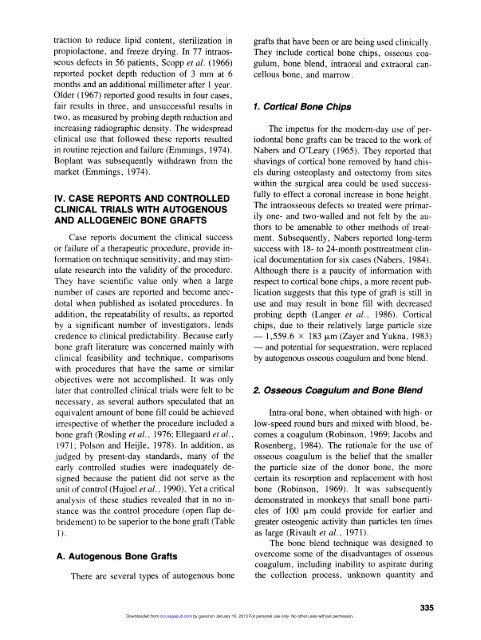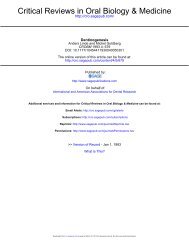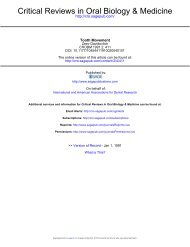Autogenous and Allogeneic Bone Grafts in Periodontal Therapy
Autogenous and Allogeneic Bone Grafts in Periodontal Therapy
Autogenous and Allogeneic Bone Grafts in Periodontal Therapy
Create successful ePaper yourself
Turn your PDF publications into a flip-book with our unique Google optimized e-Paper software.
traction to reduce lipid content, sterilization <strong>in</strong><br />
propiolactone, <strong>and</strong> freeze dry<strong>in</strong>g. In 77 <strong>in</strong>traosseous<br />
defects <strong>in</strong> 56 patients, Scopp et al (1966)<br />
reported pocket depth reduction of 3 mm at 6<br />
months <strong>and</strong> an additional millimeter after 1 year.<br />
Older (1967) reported good results <strong>in</strong> four cases,<br />
fair results <strong>in</strong> three, <strong>and</strong> unsuccessful results <strong>in</strong><br />
two, as measured by prob<strong>in</strong>g depth reduction <strong>and</strong><br />
<strong>in</strong>creas<strong>in</strong>g radiographic density. The widespread<br />
cl<strong>in</strong>ical use that followed these reports resulted<br />
<strong>in</strong> rout<strong>in</strong>e rejection <strong>and</strong> failure (Emm<strong>in</strong>gs, 1974).<br />
Boplant was subsequently withdrawn from the<br />
market (Emm<strong>in</strong>gs, 1974).<br />
IV. CASE REPORTS AND CONTROLLED<br />
CLINICAL TRIALS WITH AUTOGENOUS<br />
AND ALLOGENEIC BONE GRAFTS<br />
Case reports document the cl<strong>in</strong>ical success<br />
or failure of a therapeutic procedure, provide <strong>in</strong>formation<br />
on technique sensitivity, <strong>and</strong> may stimulate<br />
research <strong>in</strong>to the validity of the procedure.<br />
They have scientific value only when a large<br />
number of cases are reported <strong>and</strong> become anecdotal<br />
when published as isolated procedures. In<br />
addition, the repeatability of results, as reported<br />
by a significant number of <strong>in</strong>vestigators, lends<br />
credence to cl<strong>in</strong>ical predictability. Because early<br />
bone graft literature was concerned ma<strong>in</strong>ly with<br />
cl<strong>in</strong>ical feasibility <strong>and</strong> technique, comparisons<br />
with procedures that have the same or similar<br />
objectives were not accomplished. It was only<br />
later that controlled cl<strong>in</strong>ical trials were felt to be<br />
necessary, as several authors speculated that an<br />
equivalent amount of bone fill could be achieved<br />
irrespective of whether the procedure <strong>in</strong>cluded a<br />
bone graft (Rosl<strong>in</strong>g et al., 1976; Ellegaard et al.,<br />
1971; Poison <strong>and</strong> Heijle, 1978). In addition, as<br />
judged by present-day st<strong>and</strong>ards, many of the<br />
early controlled studies were <strong>in</strong>adequately designed<br />
because the patient did not serve as the<br />
unit of control (Hujoel et al., 1990). Yet a critical<br />
analysis of these studies revealed that <strong>in</strong> no <strong>in</strong>stance<br />
was the control procedure (open flap debridement)<br />
to be superior to the bone graft (Table<br />
1).<br />
A. <strong>Autogenous</strong> <strong>Bone</strong> <strong>Grafts</strong><br />
There are several types of autogenous bone<br />
grafts that have been or are be<strong>in</strong>g used cl<strong>in</strong>ically.<br />
They <strong>in</strong>clude cortical bone chips, osseous coagulum,<br />
bone blend, <strong>in</strong>traoral <strong>and</strong> extraoral cancellous<br />
bone, <strong>and</strong> marrow.<br />
1. Cortical <strong>Bone</strong> Chips<br />
The impetus for the modern-day use of periodontal<br />
bone grafts can be traced to the work of<br />
Nabers <strong>and</strong> O'Leary (1965). They reported that<br />
shav<strong>in</strong>gs of cortical bone removed by h<strong>and</strong> chisels<br />
dur<strong>in</strong>g osteoplasty <strong>and</strong> ostectomy from sites<br />
with<strong>in</strong> the surgical area could be used successfully<br />
to effect a coronal <strong>in</strong>crease <strong>in</strong> bone height.<br />
The <strong>in</strong>traosseous defects so treated were primarily<br />
one- <strong>and</strong> two-walled <strong>and</strong> not felt by the authors<br />
to be amenable to other methods of treatment.<br />
Subsequently, Nabers reported long-term<br />
success with 18- to 24-month posttreatment cl<strong>in</strong>ical<br />
documentation for six cases (Nabers, 1984).<br />
Although there is a paucity of <strong>in</strong>formation with<br />
respect to cortical bone chips, a more recent publication<br />
suggests that this type of graft is still <strong>in</strong><br />
use <strong>and</strong> may result <strong>in</strong> bone fill with decreased<br />
prob<strong>in</strong>g depth (Langer et al, 1986). Cortical<br />
chips, due to their relatively large particle size<br />
— 1,559.6 x 183 fxm (Zayer <strong>and</strong> Yukna, 1983)<br />
— <strong>and</strong> potential for sequestration, were replaced<br />
by autogenous osseous coagulum <strong>and</strong> bone blend.<br />
2. Osseous Coagulum <strong>and</strong> <strong>Bone</strong> Blend<br />
Intra-oral bone, when obta<strong>in</strong>ed with high- or<br />
low-speed round burs <strong>and</strong> mixed with blood, becomes<br />
a coagulum (Rob<strong>in</strong>son, 1969; Jacobs <strong>and</strong><br />
Rosenberg, 1984). The rationale for the use of<br />
osseous coagulum is the belief that the smaller<br />
the particle size of the donor bone, the more<br />
certa<strong>in</strong> its resorption <strong>and</strong> replacement with host<br />
bone (Rob<strong>in</strong>son, 1969). It was subsequently<br />
demonstrated <strong>in</strong> monkeys that small bone particles<br />
of 100 |xm could provide for earlier <strong>and</strong><br />
greater osteogenic activity than particles ten times<br />
as large (Rivault et al, 1971).<br />
The bone blend technique was designed to<br />
overcome some of the disadvantages of osseous<br />
coagulum, <strong>in</strong>clud<strong>in</strong>g <strong>in</strong>ability to aspirate dur<strong>in</strong>g<br />
the collection process, unknown quantity <strong>and</strong><br />
Downloaded from<br />
cro.sagepub.com by guest on January 10, 2013 For personal use only. No other uses without permission.<br />
335




